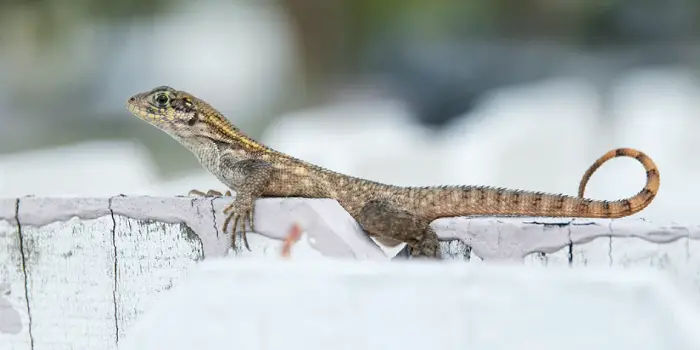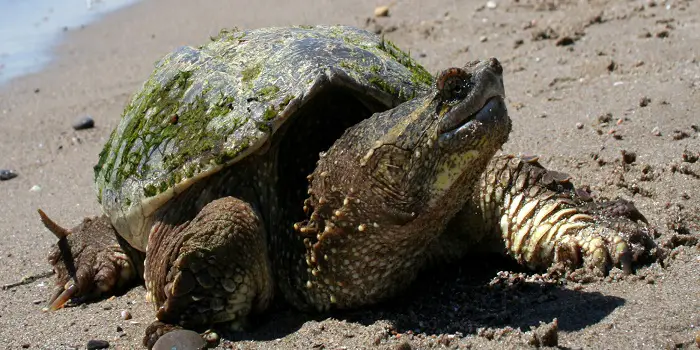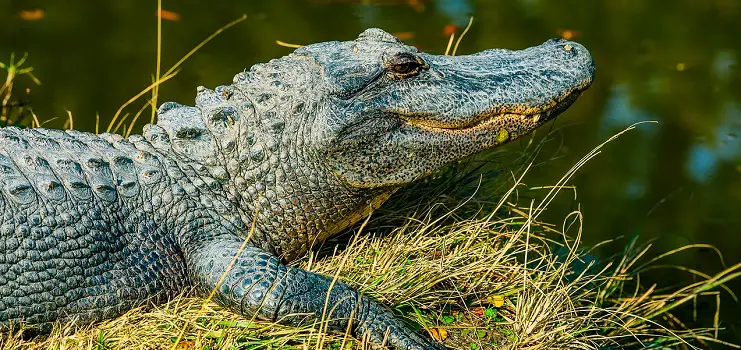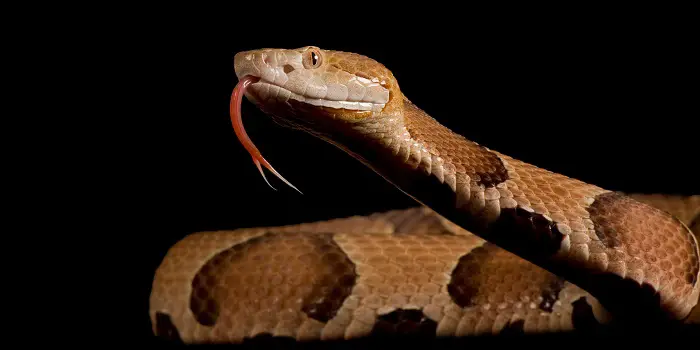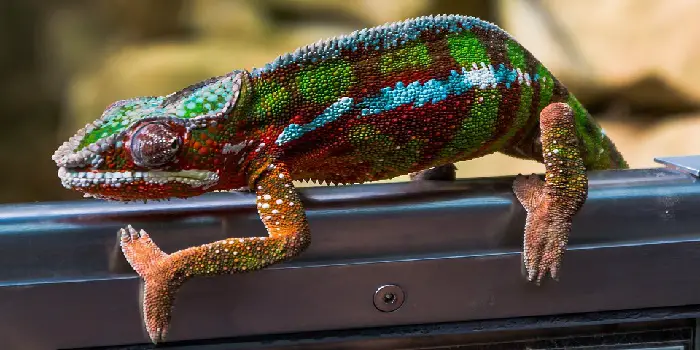
Unlike many beliefs, chameleons are reptiles and not mammals.
They are considered to be mammals by many due to the fact that some species give birth to live offspring just like a mammal.
But the truth is most of them lay eggs (like other reptiles) and are therefore categorized as reptiles.
Another reason they are grouped as reptiles is that they are cold-blooded in nature and not warm-blooded like most mammals.
Well, if you find Chameleons in your home, garden, or backyard, it’s obvious you will not like them to be there (unless you have them as a pet).
Here I will discuss a few different ways by which you can get rid of these small pesky creatures without causing any harm to them or without actually killing them.
But before I proceed, let’s check whether they are harmful and whether you should be concerned about removing them from your home immediately…
Are Chameleons Dangerous?
Chameleons are solitary animals.
They are neither venomous nor poisonous.
Although they are not very harmful to humans, they can hiss or bite if threatened or tried to catch.
Plus, the bite of a chameleon is painful but may not be toxic or harmful to humans.
Although chameleons are kept as pets by many around the world, they can be a major nuisance for your home and garden.
If not controlled, they can even hunt around your back garden and can lower the population of beneficial insects like bees and butterflies.
So it’s important to check out different methods that can help you get rid of them from your property.
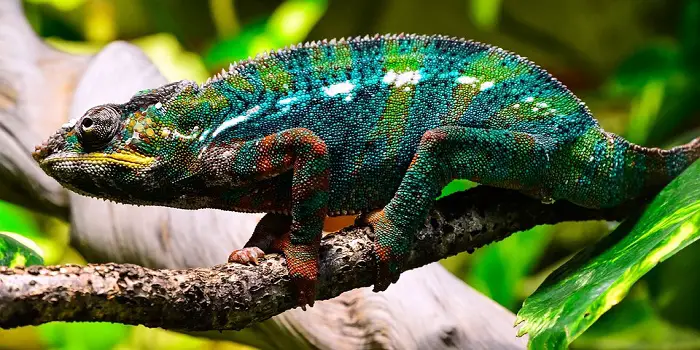
How to Get Rid of Chameleons (5 Different Methods)
Chameleons are the type of creatures that can easily venture inside your house if they are given a chance.
This means they will definitely come and find their prey inside if they find any openings and ways to let in.
The good thing is you can avoid getting bitten by chameleons by properly handling them.
Below are a few tips you can follow to help control your chameleon problem:
Method 1- Catch and remove
Catching and removing a chameleon from your place is one of the best ways by which you can get rid of them without killing it.
You can either catch a chameleon with your hands or try glue boards.
You can also try making a trap for capturing them using a cardboard box and cellophane.
- To catch a chameleon (on floor or wall), first, spray a mist of cold water that will slow down them by making them stiff and immobile for a while
- Then slowly approach from the back and catch it with your hand or trap it in a box.
- If you are catching a chameleon in the grass, you can simply drop a box onto it to quickly capture
- When catching the chameleon by hand, make sure you grab it from a belly and not by its tail or near the mouth.
- Also, make sure that you wear disposable latex gloves to prevent the transfer of Salmonella and other germs.
After catching them, you can take them outside and leave them at a faraway place in the wild.
Depending on the place you live and the species of reptile you want to remove, you may want to contact your local department of environmental protection before releasing them out.
I have many times tried this method, and believe me; it’s completely safe and easy.
I know many of you may fear catching the chameleons and other reptiles (like lizards) by hand.
So, let’s move to the next method, which does not involve catching them by hand.
Method 2- Use spray repellent
Spray repellent is a remedy that is simple and easy to use.
You can try these two methods to repel the hiding chameleons in your house:
A) Pepper spray
Lizards and chameleons are mainly allergic to pepper.
A DIY pepper spray can therefore be used to irritate them and make them leave your place.
- Crush some black pepper
- Mix it with water filled in a sprayer
- Spray this solution all over your house, including the walls, floors, and ceilings
B) Tabasco sauce spray
Similar to pepper spray, chameleons do not like the smell of Tabasco sauce.
- Fill the spray bottle with water
- Mix two teaspoons of Tabasco sauce into it
- Spray the mixture all over the areas where the chameleons normally hide
You can also repeatedly spray these solutions on the chameleon’s body directly.
This will create a burning sensation for them, which feels unpleasant.
And as a result, they will flee away fast.
Method 3- Electronic pest repellent
An electronic pest repeller is a great device that can be purchased and used for repelling chameleons away from your house and garden.
You can purchase them either from your local home & garden store, supermarket, or at online stores like Amazon, eBay, or Walmart.
These devices emit a high-frequency noise that is audible to reptiles (lizards, chameleons, and others) but not to humans.
Since they do not like these sounds, they will try to get away from them as soon as possible.
The good thing about using these ultrasonic electronic pest repellers and infrared technologies is they help in getting rid of other uninvited pests like mosquitos, mice, and others.
The thing to remember while using these devices is that they can also create trouble for your dogs and cats at home.
So, you should only use these devices if you do not have pets.
Method 5- Have a cat in the house.
If you have a cat as a pet in your house, you can release it to hunt and kill chameleons.
Although it seems to be sweet and calm, your cat will not hesitate to kill chameleons and other lizards that may be present in your home or garden.
If you do not have a cat at home, you can also have a borrowed one for a day to perform a task for you.
Method 5- Get rid of insects and other food sources
Chameleons find your property attractive because of the food and shelter they can get here.
Take a walk around your garden, and you will find that there may be a large number of chameleons residing, especially when you have a large number of insects (like bees, locusts, grasshoppers, mantids, and crickets) nesting.
Some larger-sized chameleons may also prey on small birds and other small lizards that may be coming into your back garden.
If you can get rid of these insects to remove their food source, the chameleons will most probably forage somewhere else.
You can use a bug spray to kill these insects as an effective remedy.
Also, spray the insect killer around the entrances of your home to prevent the chameleons from coming.
Plus, you should try to eliminate the debris, clutter, or leftovers around the outside of your home.
These are the places where they hide and feed.
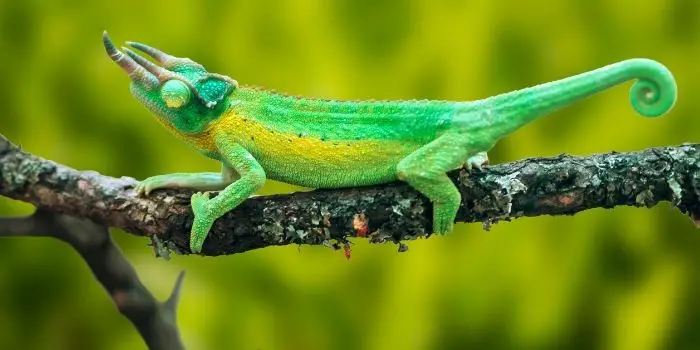
How Aggressive are Chameleons?
Depending on how you handle them, wild chameleons in your yard can be very aggressive and can even bite you.
Most of the time, they will not behave aggressively but if they tend to be, you can try to make them calm and minimize the aggression before you catch or deter them away.
Approach slowly
When trying to catch them for removal, try to approach them very slowly.
Try to avoid making any quick movements as this can give them an indication that you are a threat to them.
Do not catch them by hand.
When capturing, it’s good not to use your hands. Instead, you can use a cardboard box or a plastic bag to trap them for relocation.
Capturing a chameleon by hand can make them aggressive, and they can be a risk for you if they bite aggressively.
Why Do Chameleons Bite – Does it Hurt?
As I have mentioned before, chameleons, like other reptiles, can bite – but they do this only in rare circumstances.
Biting is a last resort for chameleons to protect themselves when they feel they are in trouble.
Unlike other reptiles like snakes, chameleons only bite when they are stressed, angry, or frightened.
Before biting, they will actually try to ward you off by opening their mouth, hissing, or by changing their color.
At last, if biting is the only solution for them, they will not hesitate.
Although it’s a tough decision for him to take as they are taking action on a creature who is much larger and more powerful than him.
The good thing is that the bite of most chameleon species does not hurt. Most of the time, it’s like a stinging sensation without breaking the skin.
However, there may be some larger species out there in the wild (like Veiled, Jackson’s chameleon, and Panther chameleons) that have powerful jaws and sharper teeth.
When bitten by them, it can hurt, break the skin, and can cause bleeding.
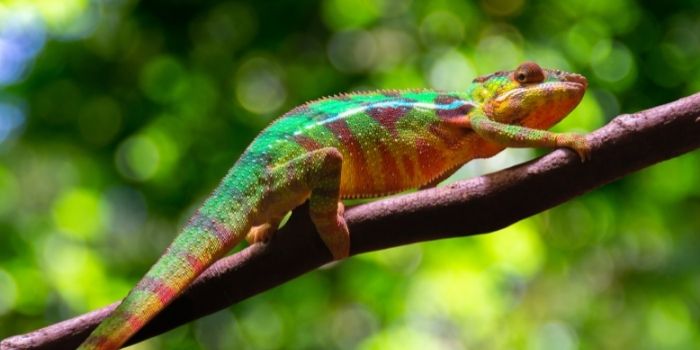
How to Avoid the Bite – What to Do if Bitten?
The best way avoids a chameleon bite is by approaching them slowly and by avoiding making them aggressive.
Before you get closer, try to trap or capture them, it’s also good to know more about them and the signals they leave before biting.
Some of the warning signs that can tell if a chameleon will bite you are:
- Puffing up
- Glaring eyes
- Wide opened mouth
- Turning black or other colors
- Sharp hiss and the final lunge
Despite all the warning signs and cautiousness, if you are unlucky and have been bitten by a chameleon, try not to panic.
Since they are not poisonous, you will not be going to die from their bite.
The very first step you should take is to avoid pulling out your finger or hand immediately out of his mouth.
If you do this, you will be worsening the bite as the chameleon may grind its teeth powerfully due to this action.
Once the bite is over, and the chameleon has released the hold, you should slowly move away from your hand.
Check the bitten area for any blood or wound.
Treat it by putting some antiseptic lotion and band-aid, the same way you do if you have a small cut by a blade.
Chameleons, like other reptiles and amphibians, can carry bacteria called Salmonella.
This can cause serious illness.
So, it’s also good to seek medical advice and treatment, especially if you find the wound swelling.
When and Why Do Chameleons Change Their Color?
Chameleons are colorful lizards that are known for changing their colors.
However, it’s a common misconception that they change color to match their surroundings or to camouflage themselves.
Chameleons change their color to maintain a favorable body temperature since they cannot generate their body heat like other animals.
But sometimes, they also quickly change their body color to communicate their intentions to other chameleons.
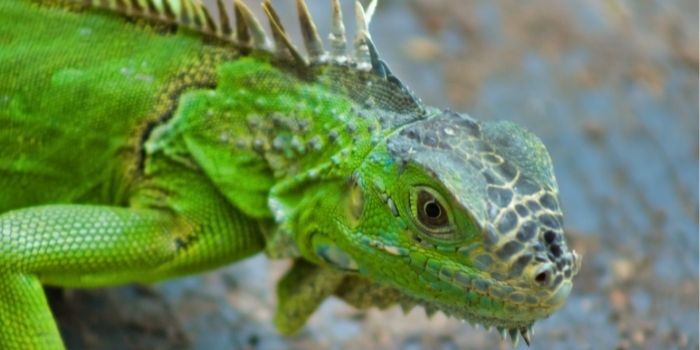
Is a green anole a chameleon?
Green anole (also called Carolina anole or American chameleons), although they can change their color, are not true chameleons.
Green anoles are native to the United States and are considered attractive little lizards that can also be kept as cute little pets for kids.
What’s the natural color of chameleons and why do they turn black?
In their relaxed, natural state, chameleons appear to be green.
As mentioned, they change their colors to regulate their body temperature.
This also means that they can change color according to their mood, which may affect their body temperature.
- Under stress, they may change the color to dark or even black
- When happy or relaxed, they may seem to be blue or bright green
- When dead, they are again dark and dull-colored due to the distressed state they may have
Other Related Questions:
What do chameleons smell like?
Unlike popular belief, chameleons are not stinky but they smell much like rotten meat.
Particularly when they rub the jaws against a tree branch, they tend to release foul-smelling wax material that attracts the prey.
Also, chameleons’ poop which appears to be a creamy white mass, smells like the urine of humans to some extent.
Why do chameleons rotate their eyes?
Chameleon rotates their eyes in search of prey.
Due to their 342-degree field of vision, they have an extraordinary power to remain still and scan for their prey without moving their heads.
Like many other reptiles, they can also observe what is behind them without moving.
What body part keeps a chameleon safe?
Camera-like rotatable eyes, color-changing scales on the body, and a long projectile tongue are all the mechanisms of the chameleon’s body that help them survive within their environment safely.
The conclusion
Eliminating the chameleons and other lizards COMPLETELY from your property may be hard to achieve.
But you can try the methods mentioned above to keep them away and stay protected.
In addition to all the above, you should also make sure that you fill up all the gaps (like under the doors), cracks, and cervices (like in window trims) from which these creatures enter.
Also, check the areas around your roof-line for holes around cables, pipes or wires, broken vent screens, etc.
Fixing all these issues will certainly help in reducing the pests like chameleons.
Share the post "5 Ways to Getting Rid of Chameleons – In the House and Garden"

Welcome to ProShieldPest.com. I am Tina Jones. I have been working as a pest removal professional in Winslow, Arizona lately. At present, I love to spend my time with my family as a retiree.
Here I share all my knowledge and experiences to help people understand better how they can stop pests at their homes without actually killing them. Hopefully, the information you will find here will help in safeguarding your home! You can check more about me here.

